 |
 |

My Yamaha YBL-622 bass trombone, an instrument I developed with Yamaha over a period of years which I now use for most of my playing. It is commercially available from Yamaha; gold brass bell, .562 bore, detachable 2nd valve (which will allow the horn to play as a single valve instrument). The instrument I play is identical to production models with the exception of the hand engraving I had done to the bell. |
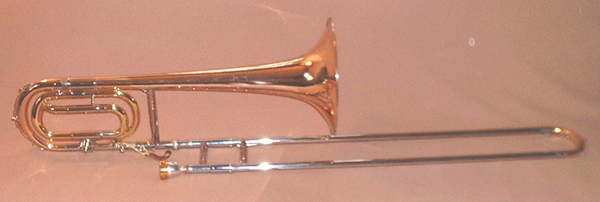
When the Boston Symphony plays repertoire of the classical and early romantic periods, our section often scales our equipment down a bit for better blending with a smaller orchestra. At the bottom of a section which includes an alto trombone on top and a small bore tenor trombone in the middle, I often play the Yamaha YBL-601 bass trombone, a Vienna model small bore bass trombone. It is beautifully made with a single valve (operated with a thumb strap of leather). |

This old Schmidt bass trombone is one I use in the Boston Symphony for classic and romantic era music, in some of the same applications I use the Yamaha YBL-601. It is a wonderful instrument with a very warm sound. Made just after World War I, it was originally owned by BSO bass trombonist Hans Durck Waldemar Lillebach who sold it to his student, Kauko Kahila who also played bass trombone in the Boston Symphony (1952-1972). Kahila passed the horn on to me a few years ago and I've used it in many works with the Boston Symphony including Beethoven "Missa Solemnis" and several Brahms Symphonies. The instrument is a dual bore, .525/.547 with a 10" bell. There is no tuning slide on the main horn; the valve section is in E. |
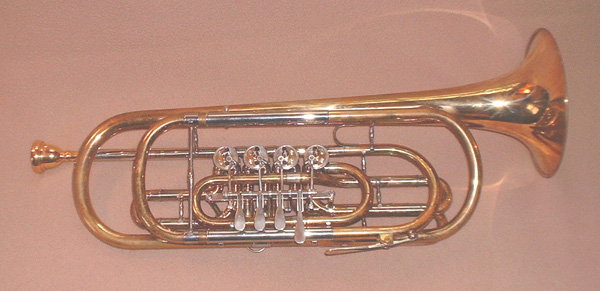
When called for, I play bass trumpet in the Boston Symhony. This is a Yamaha bass trumpet in C, a prototype, one of two which Yamaha made. The other is being played in an orchestra in Germany. I use this instrument when we play any of Wagner's "Ring Cycle" operas. |
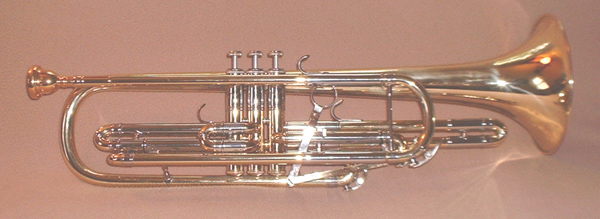
This Bach B flat bass trumpet was made in New York City and was previously owned by William Gibson, former principal trombonist of the Boston Symphony. It has a mechanism which allows the main tuning slide to move with the use of a finger ring, a very useful feature! I use this instrument when playing any of the "band" pieces which require bass trumpet including Stravinsky's "Rite of Spring" and the Janacek "Sinfonietta." |

The G bass trombone was the standard bass trombone in England for much of the 19th and 20th centuries. This G bass trombone was made by the Salvation Army and was previously owned by the Cambridge (Massachusetts) Citadel Corps of the Salvation Army. The instrument is quite long which necessitates the use of a handle to reach the outer positions. |

Several years ago I acquired an exceptionally fine G bass trombone made by Boosey and Hawkes. This instrument features a valve that puts the instrument in the key of D, allowing for a more fully chromatic range than the G bass without a valve. This instrument was featured in Arnold Myer's article, "Brasswind Manufacturing at Boosey & Hawkes, 1930-59" that appeared in the Historic Brass Society Journal, Volume 15, 2003. This instrument, manufactured in 1938, is known as the "Betty model trombone" because it was designed for bass trombonist William Betty. Boosey & Hawkes made 18 of these instruments up until 1939 and 20 more from 1947-1959. The "Betty model" is a wider bore than most G bass trombones of the period (the bell is eight inches in diameter) and it has an exceptionally warm sound, so much so that I have used it in the Boston Symphony in performances of Elgar's "Cockaigne Overture" conducted by Sir Jeffrey Tate at Tanglewood in 2002 as seen in the photo below. |

This is a remarkable instrument, perhaps one of the few existing specimens of a BB flat contrabass trombone made by the Salvation Army over 100 years ago. Records for the Salvation Army instrument factory in England do not go back far enough to date this instrument (serial number 11732) but it appears in a catalog dated 1905. In his booklet, 'The Slide Trombone," (new edition, 1929), Lt. Colonel F. Gl Hawkes wrote: "Only a strong, healthy person will be able to manage this instrument, as it requires a large quantity of wind to fill it." The instrument has a very small bore, much smaller than my Conn BB flat contrabass trombone (see below). Gordon Taylor, archivist of the International Heritage Centre of the Salvation Army in London has told me he was unaware any of these instruments had survived to the present day. |
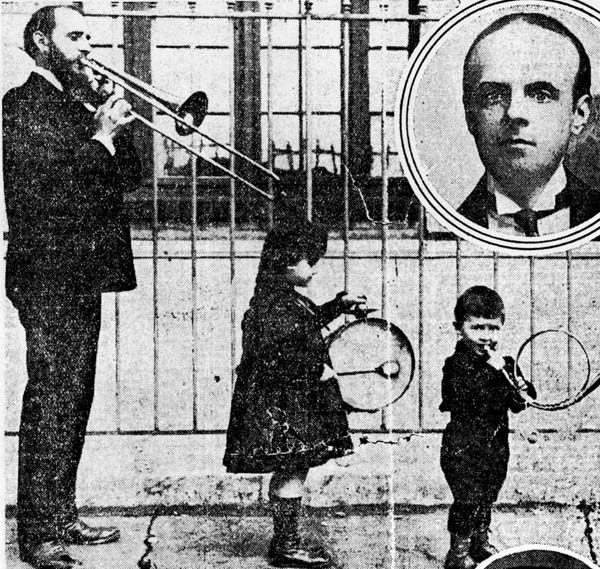
Joannes Rochut is well known to trombone players as the editor of three volumes of "Melodious Etudes" from the works of Marco Bordogni (pub. Carl Fisher). For me, there is another strong connection with Rochut: he played principal trombone in the Boston Symphony from 1925-1929. A native of France, Rochut brought at least two trombones with him when he joined the BSO which are now part of my collection. The photo above shows Rochut in Paris before he joined the BSO with his daughter and son. Rochut is playing the instrument discussed below. The photo, reproduced in a Boston newspaper in October 1925, has the following caption: Joannes Rochut, new first trombone of the Boston Symphony Orchestra, and his daughter and son. This charming family snapshot was made before the war, but M. Rochut prefers it to more pretentious photos made since. Fredinand Gillet, who joined the BSO as principal oboist at the same time Rochut joined the orchestra, is shown in the circular inset at the top right of the photo. To see another photo of Rochut holding this instrument along with other members of the Boston Symphony Orchestra around 1926, visit my extensive resource, The Eugene Adam Collection. (ABOVE) This is a photo of Rochut's primary instrument, a B flat tenor trombone made by Lefevre of Paris. Lefevre was active around 1910; his shop was at rue du Theatre 148. The instrument has a very small bore and a bell six inches in diameter. |

The second trombone of Joannes Rochut that I have in my collection is a very interesting instrument. While Rochut's primary instrument (above) was a "straight" tenor trombone, he also owned an instrument with an "f attachment." Also made by Lefevre and having a slide with the same narrow bore as his straight tenor, this instrument has a 6.5 inch diameter bell, a pisto valve to put the instrument into F and a rotary valve that can be turned by hand to further put the instrument into E. |

Ever since I was a young boy I have been fascinated by the buccin, the late 18th and early 19th century French form of trombone that had a bell ending in a zoomorphic head. In 2004 I finally had the opportunity to purchase a buccin bell from an instrument dealer in Paris. This bell was made by Francois Sautermeister of Lyon (France) who was active until 1830. It is very difficult to find a complete, working buccin today. Usually the hand slide is in dreadful condition and all buccin slides, like trombones of the period, were unplated. I wanted to play my buccin (Berlioz wrote a part for buccin in his "Messe solennelle") so I decided to purchase only the bell and have a modern slide constructed after historical models. The slide was made by Jim Becker at Osmun Music (Arlington, Massachusetts) after research of historical buccin slides in various museums including Boston's Museum of Fine Arts. There is a tuning slide at the bottom of the slide and there is no water key or slide lock. Jim Becker also did extensive restoration of the bell - he is a superb craftsman and truly brought this instrument back to life. |

I purchased this B flat tenor trombone at an auction a few years ago, it awaits restoration. It was made by Gustav A. Wagner of Dresden, Germany, and has the characteristic German style valve section with a very small rotary valve. |
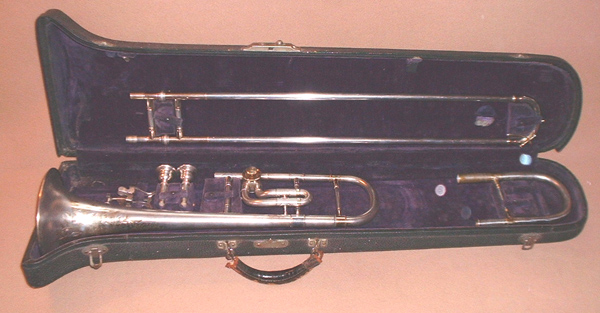
This is one of the most unusual instruments in my collection. It is a tenor trombone in C made by Conn, serial number 134276 (made around 1924) and goes by the name, "The Preacher Model." Here the instrument is shown in its original case with accessories including two original Conn mouthpieces, lyre and low pitch tuning slide. The Conn "Preacher Model" is in C, but has a valve which can be turned by hand which will put the trombone in B flat. The reason for this is really quite simple: if a person was accustomed to reading music for trombone in B flat treble clef, they could read music written in C treble clef, put the trombone in C and then read music as if it were in B flat and have it sound in concert pitch. Hence, the name "Preacher Model" - the preacher could lead music from the pulpit with his trombone, playing out of the hymnal. The instrument is in beautiful condition, very small, and a gem of Conn's innovative instrument development. |

Yamaha has begun marketing a new "compact trombone" that is built on a similar principle to the Conn "Preacher model" trombone above. The Yamaha YSL-350C is a truly innovative instrument. Many beginning trombonists have difficulty reaching the instrument's outer positions because their arms are not very long. This can be frustrating for the young player and many beginners have given up on the trombone as a result. One would think that you could not make a B flat tenor trombone that would be smaller than a full size tenor trombone - after all you need nine feet of tubing to play a b flat. But Yamaha has built a trombone in C with a reverse valve. Here's how it works: The trombone is made in the key of C but when the valve lever is not activated, the valve is "open" so air goes through the valve. The added tubing of the valve makes the trombone in B flat. When the valve lever is activated, the valve is closed so the trombone is in the key of C. As a result, the trombone is shorter than a normal trombone AND when the valve lever is activated, the young player can reach C and B natural which are ordinarily played in 6th and 7th position on a standard trombone. This trombone does have limitations: there is no 7th position on the instrument so a low E cannot be played either with or without the valve. But the compact size and the fact that low C and B can be played with the valve makes this instrument an attractive alternative for the young trombonist. The slide positions relate visually to the bell the same as they do on a standard trombone which makes the transition from this compact trombone to a standard trombone very easy once the players arms are longer. I own one of these instruments because whenever I am on vacation I need to take a trombone to practice. Not always wanting to check my bass trombone as baggage and realizing that it simply won't fit an overhead compartment as a carry on bag, the Yamaha compact trombone is the perfect vacation companion. It has a great, compact case that easily fits in an airplane overhead. It is light and also has a carrying strap for the case. I truly think this trombone is one of the best purchases I've ever made. Never did I dream I'd have a trombone that would be so compact but also sound so good. For more information on the Yamaha YSL-350C compact trombone, visit the website devoted to the instrument on the Yamaha Band Instrument Website. |

This is a remarkable instrument, a Conn contrabass trombone in BBflat, made in 1903 (serial number 69213) for Auguste Helleberg, former tuba player with the Chicago Symphony and the Metropolitain Opera Orchestra. From what I've learned, there were not many of these made. In beautiful condition, it features a double slide and large bell. I use this instrument in the Boston Symphony when I play parts by Wagner on contrabass trombone. |

This Latzsch contrabass trombone is in F with valves to E flat and B flat. Owned by the Boston Symphony Orchestra, I use it primarily when playing cimbasso or "trombone basso" (4th) parts in Italian operatic works including Puccini's "Madama Butterfly" and the Verdi "Requiem." A close up view of the valve section of the Latzsch contrabass trombone in F/Eflat/Bflat. |

In recent years I have been enjoying exploring historical instruments including serpent, ophicleide and buccin. I also play bass sackbut and have a fine instrument made by Frank Tomes of London in 1996. This instrument is in F and is made after an historical model made in Nurenburg, Germany. |
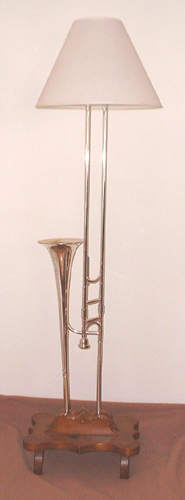 This lamp was made by my father-in-law from an old King/H. N. White trombone,
serial number 69519. The trombone was given to me by the organist at a
church at which my father was pastor in 1971. It was in terrible shape,
but I saw the possibilities immediately. In high school, I had a band
director who used to shout, "If you're not going to practice, then take
your trombone and make a !$#@%*! lamp out of it!" So that's what I did.
I had the trombone restored to at least a decent visual appearance and
turned it over to my father-in-law who made a wooden base for it and did
the wiring. The lamp sits in our living room where the bell makes a nice
holder for my ubiquitous glass of iced tea - and it is also a very interesting
conversation piece!
This lamp was made by my father-in-law from an old King/H. N. White trombone,
serial number 69519. The trombone was given to me by the organist at a
church at which my father was pastor in 1971. It was in terrible shape,
but I saw the possibilities immediately. In high school, I had a band
director who used to shout, "If you're not going to practice, then take
your trombone and make a !$#@%*! lamp out of it!" So that's what I did.
I had the trombone restored to at least a decent visual appearance and
turned it over to my father-in-law who made a wooden base for it and did
the wiring. The lamp sits in our living room where the bell makes a nice
holder for my ubiquitous glass of iced tea - and it is also a very interesting
conversation piece!
|
|
©1996-2005 by Douglas Yeo. All rights reserved. |